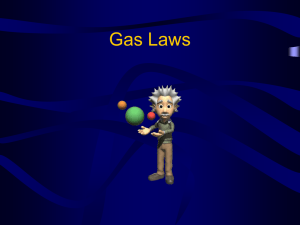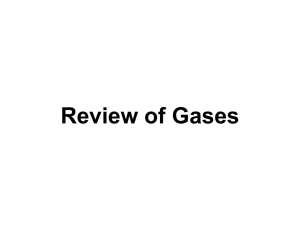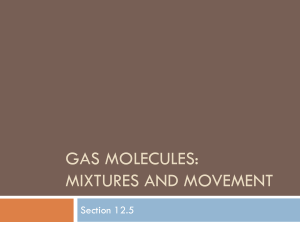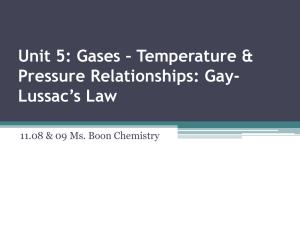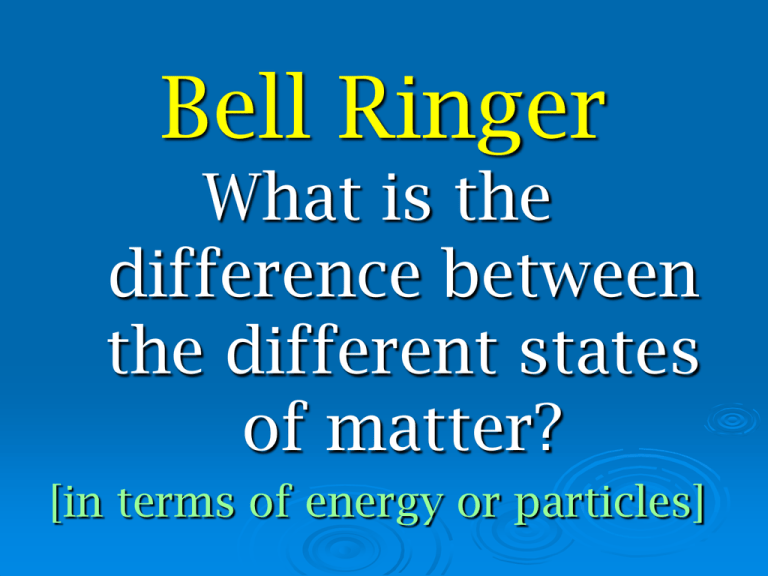
Bell Ringer
What is the
difference between
the different states
of matter?
[in terms of energy or particles]
based on the idea that particles are
constantly moving
can be applied to solid, liquid, or gas
provides a model of ideal gas
behavior so it is only an
approximation
Ideal student
Real student
1. Gases consist of tiny particles
that are very far apart
most volume is empty spacelow density
allows gases to be easily compressed
2. All collisions between particles
and container walls are elastic
there is no net loss of energy when
particles collide
total kinetic energy stays constant
even though it can be transferred
between particles
3. Particles are in continuous,
rapid, random motion
since they are moving, they have KE
KE overcomes their attractive forces
4. No forces of attraction or
repulsion
YOU ARE ATTRACTED
TO EVERYTHING!
Average kinetic energy depends
on temperature
KE increases as temperature increases
At the same T, lighter particles have
higher speeds than heavier ones
velocity and temperature are directly
proportional
ideal gas is defined by the KMT
most gases behave close to the ideal
when there is:
HIGH temperature – so they have enough
KE to overcome attractive forces
Low pressure – so they are very spread out
Gases with little attraction, low mass,
are more ideal (monatomic gases)
Create a cartoon that helps to
explain the KMT to other students!
Grade will be based upon:
Creativity
Effort
Use of color
Bell Ringer
List the 4 parts
of the KMT.
P : amount of force in an area
Why would shoes with smaller diameter heel
not be allowed on gym floor?
As surface area decreases, pressure
increases
Pressure exerted by a gas depends on
volume
temperature
number of molecules
STANDARD TEMPERATURE &
PRESSURE
STP
Standard Temperature = 0°C
Standard Pressure = 1 atm
Pressure and Temperature
STP (Standard Temperature and Pressure)
standard temperature
0 oC
273 K
standard pressure
1 atm
101.3 kPa
760 mm Hg
Equations / Conversion Factors:
K = oC + 273
oC = K – 273
1 atm = 101.3 kPa = 760 mm Hg = 760 torr
Conversions
Convert 25oC to Kelvin.
K = oC + 273
25oC + 273 =
298 K
How many kPa is 1.37 atm?
X kPa = 1.37 atm
101.3 kPa
= 138.8 kPa
1 atm
How many mm Hg is 231.5 kPa?
X mm Hg = 231.5 kPa
760 mm Hg
= 1737 mm Hg
101.3 kPa
Practice Conversions
Is
the pressure of the vapor over a
liquid (and some solids) at equilibrium
Must be in contact with a liquid otherwise
you just have a gas!
Depends on temperature only
Vapor Pressure
measure of the tendency for liquid particles to enter
gas phase at a given temp.
a measure of “stickiness” of liquid particles to each other
more
“sticky”
less likely to
vaporize
In general:
LOW v.p.
not very
“sticky”
more likely to
vaporize
In general:
HIGH v.p.
NOT all liquids have same vapor pressure at
same temp.
Bell Ringer
If the pressure inside a tire is
248 kPa, how many
millilmeters of mercury is
that?
1860
How Vapor Pressure is Measured
Animation by Raymond Chang
All rights reserved
Behavior of a liquid in a closed
container
Boiling Point Explained
100
CHLOROFORM
80
PRESSURE 60
(kPa)
40
ETHANOL
20
WATER
0
0
20
40
60
80
100
TEMPERATURE (oC)
Volatile substances evaporate easily (have high v.p.’s).
BOILING when vapor pressure = confining pressure
(usually from atmosphere)
atmospheric pressure is 101.3 kPa
b.p. = 78oC
b.p. = 100oC
Formation of a bubble is opposed by
the pressure of the atmosphere
Boiling vs. Evaporation
Boiling point: atmospheric pressure = vapor pressure
AIR
PRESSURE
15psi
VAPOR
PRESSURE
Revolutionary process - fast
Lyophilization – freeze drying
15 psi
Evaporation: molecules go from liquid to gas phase
gas
liquid
Evolutionary process - slow
Barometer
measures atmospheric pressure
Empty space
(a vacuum)
Hg
Weight of the
mercury in
the column
Weight of the
atmosphere
(atmospheric
pressure)
Practice
Vapor Pressure
of 4 liquids
wkst
1.What is one way you can make a real gas act more ideal?
2. 92.1 kPa = _______ mmHg
3. If ethanol boils at 82°C, what is the atmospheric pressure?
4. In terms of pressure(s), when does a liquid boil?
5. Name of the two MOST ideal REAL gases?
1. Spread out, high temp or low press
2. 691mmHg
3. 110 kPa
4. When vp = atm pressure
5. H or He
Bell Ringer
According to Reference Table
H, at what temperature will
propanone boil if the
atmospheric pressure is
70kPa?
Evaporation
H2O(g)
molecules
(water vapor)
H2O(l)
molecules
Show how pressure, volume, and
temperature, are related to gases.
REMEMBER
Hold whichever variable constant to adjust the other variable to see
what would happen as a result of the desired change
If the temperature remains constant and we lower the pressure, what
must happen to the volume?
The volume must increase!
If the temperature remains constant and we lower the volume, what
must happen to the pressure?
The pressure must increase!
Relationships between volume and pressure.
Boyle’s Law: P and V
as
one increases, the
other decreases
inversely proportional
pressure is caused by moving
molecules hitting container walls
If V is decreased and the # of
molecules stays constant, there will be
more molecules hitting the walls per
unit of time
Boyle’s Law
Pressure vs. Volume
for a Fixed Amount of Gas
(Constant Temperature)
Pressure
(Kpa)
100
150
200
250
300
350
400
450
600
Volume (mL)
500
400
300
Volume
(mL)
500
333
250
200
166
143
125
110
PV
50,000
49,950
50,000
50,000
49,800
50,500
50,000
49,500
200
100
0
100
200
300
Pressure (KPa)
400
500
Chucky’s Law
(aka Charles Law)
Relationship between volume and temperature
Charles’ Law: V and T
if P is constant, gases expand when heated
when T increases, gas molecules move
faster and collide with the walls more often
and with greater force
to keep the P constant, the V must increase
Example: Boyle’s Law
Consider a 1.53L sample of gaseous SO2 at
a pressure of 5.6 x 103 Pa. If the pressure is
changed to 1.5 x 104 Pa at constant
temperature, what will be the new volume
of the gas?
P1 V1 P 2 V 2
( 5 . 6 x10 Pa )(1 . 53 L ) (1 . 5 x10 Pa )V 2
3
4
. 57 L V 2
Practice 1. If the volume of a gas at 10.0oC is 100.0 ml, then what is
the volume at -2.0oC?
V1 =V2
T1 T2
T1 = 10oC
100.0 ml = V2
V1 = 100.0 mL
10.0oC
-2.0oC
T2 = -2.0oC
10.0 x V2 = -200
V2 = ?
V2 = -20. ml
We can’t have negative volumes, so we can’t use a temperature
scale with negatives
V1 =V2
With gas laws, ALWAYS USE KELVIN
T1 T2
T1 = 10oC 283 K
100.0 ml = V2
V1 = 100.0 mL
283 K
271 K
T2 = -2.0oC 271 K
V2 = ?
283 x V2
= 27100
V2 = 95.7597 mL 96 mL
Gas Laws pkt
Vapor Pressure wkst
Charles’ Law: V and T
Charles’ Law: the V of fixed mass of gas at
constant P varies directly with
temperature.
What kind of graph is V vs. T?
V1
T1
V2
T2
Boyle’s Law
• As the pressure
on a gas
increases the volume
decreases
1 atm
2 atm
4 Liters
2
• Pressure and
volume are
inversely related
Pressure-Volume Relationship
250
(P3,V3)
Pressure (kPa)
200
150
(P1,V1)
100
(P2,V2)
50
P1 = 100 kPa
V1 = 1.0 L
P2 = 50 kPa
V2 = 2.0 L
P3 = 200 kPa
V3 = 0.5 L
P1 x V1 = P2 x V2 = P3 x V3 = 100 L x kPa
0
0.5
1.0
1.5
Volume (L)
2.0
2.5
P vs. V (Boyle’s Data)
Example: Charles’ Law & Temp.
A sample of gas at 15.0°C and 1.00 atm has
a volume of 2.58 L. What volume will this
gas occupy at 38.0°C and 1.00 atm?
P1 = 1.00 atm
T1 = 15.0oC = 288K
V1 = 2.58 L
V1 =V2
T1 T2
2.58 L
288K
V2 x 288K
V2
= V2
311K
= 802L*K
=
2.79L
P2 = 1.00 atm
T2 = 38.0oC = 311K
V2 = ?
Bell Ringer
If the pressure on a gas is
decreased by ½, how much
larger will the volume
become?
2. Which gases makes the most
ideal gases real gases?
1.
Cooling Curve Review
Gas Laws Lab
Bell Ringer
Four identical balloons contain equal volumes of gas at STP.
A.
B.
Balloon #1 contains H2 gas
Balloon #2 contains He gas
Balloon #3 contains O2 gas
Balloon #4 contains N2 gas
Which balloon would weigh the most?
Explain
According to the KMT, why would the
balloons expand upon heating?
Bell Ringer
If you have a basketball that
has a volume of 2.2L at a
pressure of 3.00atm.
What would it’s volume be
at Standard Pressure?
1. As the temperature of a liquid increases, its vapor
pressure
A. Increases
B. Decreases
C. Remains the same
2. According to Reference Table H, what is the vapor
pressure of propanone at 45ºC?
70.0 kPa
3. What is the name of the of the phase change that
turns a solid directly into a gas?
Sublimation
4. Which liquid on Table H has the strongest
Ethanoic Acid
intermolecular forces of attraction?
Amadeo Avogadro created two important ideas used in science
1. Hypothesis
If we have two gases with the same temperature and
pressure at the same volume, they will have the same
number of molecules.
Gases are made of mostly empty space, so the size of the
individual molecules does not matter
Example - A sample of H2(g) contains 1 x 1023 molecules at a
particular volume at STP. How many molecules of CO2(g) takes
up the same volume at STP?
Same T, same P and same V
1x
= same # of molecules
23
10
2. Molar volume of a gas
In chemistry, we use very large numbers of atoms.
So Avagadro created a large unit called Mole = 602,000,000,000,000,000,000,000 objects
Pair = 2
Dozen = 12
Mole = 6.02 x 1023
If we have one mole of ANY gas at standard temperature and
pressure, it will take up
of space
Examples
1. How much room does 6.02 x 1023 molecules of N2(g) occupy at
STP?
One mole = 22.4 L
2. How much volume does 0.5 moles of CO2(g) occupy at STP?
11.2L
3. If we have 3.01 x 1023 molecules of CO2(g) at STP, what is the
volume?
0.5 moles 11.2 L
4. How many molecules are in 44.8 L of H2S(g) at STP?
2 moles
2 x 6.02 x 1023
1.204 x 1024
5. If we have 9.03 x 1023 molecules of a gas at STP, what is the
volume?
1.5 moles
33.6 L
Dalton’s Law of Partial
Pressure
Dalton’s Law of Partial Pressure
the
total P of a mixture of gases is
equal to the sum of partial P of
component gases, no matter how
many different gases
PT
= P1 + P2 + P3 + …
Partial
Pressure- P of each gas in
mixture
Why?
the
particles of each gas in a
mixture have an equal chance
to hit the walls
so each gas exerts P
independent of that exerted by
other gases
total P is result of the total # of
collisions per unit of wall area
Table H worksheet
Bell Ringer
According to Reference Table H,
which liquid will evaporate
more rapidly?
At what temperature does
ethanol have the same vapor
pressure as propanone at
68.5˚C?
Bell Ringer
A gas sample has a volume of
25.0 ml at a pressure of 1.0
atm. If the new volume
increases to 50.0 ml and the
temperature remains
constant, the new pressure
will be?
a
gas often changes in T, P, and V all
at once
the other gas laws can be combined
into one law
Combined Gas Law- relationship
between P, V, and T of a fixed amount
of gas
Example - A gas is collected at 273 K and 2.00 atm to a
volume of 50.0 ml. What is the new pressure of a gas if the
temperature drops to 200.0 K and the volume increases to
75.0 ml?
P2 = ?
P1 = 2.00 atm
V1 = 50 mL
V2 = 75.0 ml
T1 = 273 K
T2 = 200.0 K
2.00 x 50 ml = P2 x 75.0 ml
273 K
200.0 K
20,475 x P2 = 20,000
P2 = 0.97680 atm
0.977 atm
A Helium-filled balloon has volume of 50.0
L at 25°C and 1.08 atm. What volume will
it have at 0.855 atm and 10.°C?
P1 = 1.08 atm
P2 = 0.855 atm
V1 = 50.0 L
V2 = ?
T2 = 10.°C = 283 K
T1 = 25°C = 298 K
(1.08 atm)(50.0 L)
(0.855 atm)(V2)
=
298 K
283 K
254.79 x V2 = 15282
V2 = 59.9788 L
60. L
Bell Ringer
Which 5.0 ml sample of NH3 will
take the shape of and
completely fill a closed 100.0
ml container?
A. NH3(s)
C. NH3(g)
B. NH3(l)
D. NH3(aq)
Sub
Gas Laws and Boyles Problems
Bell Ringer
Which sample at STP has the
same number of molecules as
5 liters of NO2(g) at STP?
A.5 grams of H2(g)
B. 5 liters of CH4(g)
C. 5 moles of O2(g)
D.5 x 1023 molecules of CO2(g)
A Helium-filled balloon has volume of 50.0
L at 25°C and 1.08 atm. What volume will
it have at 0.855 atm and 10.°C?
P1 = 1.08 atm
P2 = 0.855 atm
V1 = 50.0 L
V2 = ?
T2 = 10.°C = 283 K
T1 = 25°C = 298 K
(1.08 atm)(50.0 L)
(0.855 atm)(V2)
=
298 K
283 K
254.79 x V2 = 15282
V2 = 59.9788 L
60. L
Bell Ringer
A 1.00-mole sample of a neon
gas occupies a volume of
22.4 liters @ 298K and
101.3 kPa. Calculate the
density of this sample.
0.827 g/L
Bell Ringer
Using Table H, how
would you have to
adjust your cooking
time of pasta high
in the mountains?
Water rapidly boiling on a stove
Water rapidly boiling on a stove
Pressure Cooker
Copyright © 2006 Pearson Benjamin Cummings. All rights reserved.
120oC
Pressure Cooker
Copyright © 2006 Pearson Benjamin Cummings. All rights reserved.
120oC
Bell Ringer
A gas occupies a volume of
560.ml at a temperature of
100.°C. To what temperature
must the gas be changed if it
is to occupy 400.ml, with the
pressure remaining
unchanged?
Heating / Cooling Curve of Water
140
steam
Temperature (oC)
120
water and steam
100
liquid water
80
60
40
ice and
water
20
0
ice
-20
Heat added at a constant rate


